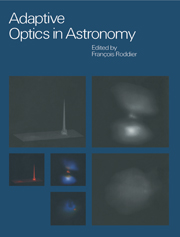Book contents
- Frontmatter
- Contents
- List of contributors
- Part one Introductory background
- Part two The design of an adaptive optics system
- Part three Adaptive optics with natural guide stars
- Part four Adaptive optics with laser beacons
- 11 Overview of adaptive optics with laser beacons
- 12 The design of laser beacon AO systems
- 13 Laser beacon adaptive optics systems
- Part five The impact of adaptive optics in astronomy
- Glossary of acronyms
- Index
11 - Overview of adaptive optics with laser beacons
from Part four - Adaptive optics with laser beacons
Published online by Cambridge University Press: 23 November 2009
- Frontmatter
- Contents
- List of contributors
- Part one Introductory background
- Part two The design of an adaptive optics system
- Part three Adaptive optics with natural guide stars
- Part four Adaptive optics with laser beacons
- 11 Overview of adaptive optics with laser beacons
- 12 The design of laser beacon AO systems
- 13 Laser beacon adaptive optics systems
- Part five The impact of adaptive optics in astronomy
- Glossary of acronyms
- Index
Summary
Motivation for using laser beacons
The goal of diffraction-limited correction of large telescopes
In Chapters 8–10, we have seen that adaptive optics (AO) is a powerful tool to enhance the resolution and contrast of astronomical images. Several 2- to 4-m class astronomical telescopes now have AO user instruments. These include the ESO and Canada–France–Hawaii 3.6-m telescope, and the Mt Wilson 100- inch telescope. All are being used for scientific observations, and are producing dramatic results, fulfilling the promise of AO to overcome the problem of seeing which has plagued astronomers for centuries.
The AO systems on the above telescopes, as well as several other systems which will be operational in the near future, use the light from a field star to sense the wave-front aberrations, as originally envisaged by Babcock (1953). As discussed in Section 3.5, to produce diffraction-limited correction a bright source must be available within the isoplanatic patch. (We will quantify this requirement in the following section.) There are many applications where a natural star can be utilized, notably in applications of AO for stellar astronomy and the search for faint companions around bright stars. In addition, many extended objects will contain a bright stellar component suitable for wave-front sensing. However, the brightness requirement for field stars is quite severe, resulting in a low probability for finding a sufficiently bright “guide” star for diffraction-limited correction (within ∼ 10″ at an imaging wavelength λi=1 μm) for arbitrary program objects.
- Type
- Chapter
- Information
- Adaptive Optics in Astronomy , pp. 255 - 270Publisher: Cambridge University PressPrint publication year: 1999
- 1
- Cited by

